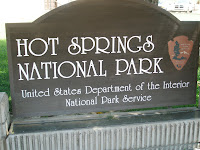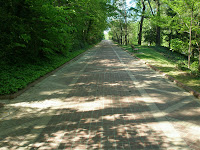






Our first stop out of Livingston, Texas was Hot Springs, Arkansas. We arrived Tuesday afternoon and decided to stay one day to explore before moving on. First we drove to the top of Hot Springs Mountain for an expansive view of the city below. We saw many possible hiking trails, perhaps for another visit when we can stay longer. Back down to historic Hot Springs and Bathhouse Row for a tour and some history of the area.
Hot Springs takes its name from the natural thermal water that flows from 47 springs on the western slope of Hot Springs Mountain into the historic downtown district of the city. (And what is really interesting is that Hot Springs National Park is actually right in the middle of downtown Hot Springs, surrounded by businesses and a busy highway.) About a million gallons of 143-degree water flow from the springs each day. The rate of flow is not affected by fluctuations in the rainfall in the area. Studies by National Park Service scientists have determined through carbon dating that the water that reaches the surface in Hot Springs fell as rainfall 4,000 years earlier. The water percolates very slowly down through the earth’s surface until it reaches superheated areas deep in the crust and then rushes rapidly to the surface to emerge from the 47 hot springs.
People have used the hot spring water in the therapeutic baths for more than 200 years to treat rheumatism and other ailments, although bathing in the spring water now is available in approved facilities only. Bathhouse Row consists of eight turn-of-the-century historic buildings. Two of the bathhouses remain in operation today – The Buckstaff, currently the sole bathhouse operating in its original capacity, and the Quapaw which was reopened in 2008 in a modern co-ed setting. Another bathhouse, the Fordyce, has been converted into a museum to give tourists a glimpse into the fascinating past of the city. As I was touring the “treatment” rooms at the Fordyce, I was reminded more of visions of water torture at sanitariums than of relaxing spa treatments. I’m too accustomed to the modern Day Spa concept, I guess!
The pictures here include the exterior of Buckstaff Baths; one of the treatment rooms in historic Fordyce; the Hot Springs National Park entrance sign; Dan at the summit of Hot Springs Mountain; the Grand Promenade trail that winds around behind the bathhouses; the Hubbard Tub that was used to treat various ailments at Fordyce; a stain glass ceiling in the men’s bath at the Fordyce.
Hot Springs takes its name from the natural thermal water that flows from 47 springs on the western slope of Hot Springs Mountain into the historic downtown district of the city. (And what is really interesting is that Hot Springs National Park is actually right in the middle of downtown Hot Springs, surrounded by businesses and a busy highway.) About a million gallons of 143-degree water flow from the springs each day. The rate of flow is not affected by fluctuations in the rainfall in the area. Studies by National Park Service scientists have determined through carbon dating that the water that reaches the surface in Hot Springs fell as rainfall 4,000 years earlier. The water percolates very slowly down through the earth’s surface until it reaches superheated areas deep in the crust and then rushes rapidly to the surface to emerge from the 47 hot springs.
People have used the hot spring water in the therapeutic baths for more than 200 years to treat rheumatism and other ailments, although bathing in the spring water now is available in approved facilities only. Bathhouse Row consists of eight turn-of-the-century historic buildings. Two of the bathhouses remain in operation today – The Buckstaff, currently the sole bathhouse operating in its original capacity, and the Quapaw which was reopened in 2008 in a modern co-ed setting. Another bathhouse, the Fordyce, has been converted into a museum to give tourists a glimpse into the fascinating past of the city. As I was touring the “treatment” rooms at the Fordyce, I was reminded more of visions of water torture at sanitariums than of relaxing spa treatments. I’m too accustomed to the modern Day Spa concept, I guess!
The pictures here include the exterior of Buckstaff Baths; one of the treatment rooms in historic Fordyce; the Hot Springs National Park entrance sign; Dan at the summit of Hot Springs Mountain; the Grand Promenade trail that winds around behind the bathhouses; the Hubbard Tub that was used to treat various ailments at Fordyce; a stain glass ceiling in the men’s bath at the Fordyce.
2 comments:
that sounds interesting...do you have wear a bathing suit??? lol!
Hi Nancy! Hmmm... I don't know about the bathing suit, hehe!
Post a Comment